University Economics: Economic Problem Solving Exercises Report
VerifiedAdded on 2022/09/08
|7
|1398
|21
Report
AI Summary
This report delves into economic problem-solving exercises, differentiating between microeconomic and macroeconomic approaches. In microeconomics, it discusses utility maximization and market equilibrium, emphasizing the role of price mechanisms in adjusting demand and supply. The report also explores macroeconomic challenges like inflation and unemployment, highlighting the use of fiscal and monetary policies as problem-solving tools. Fiscal policy, involving government expenditure and revenue, and monetary policy, focusing on interest rates and money supply, are presented as key strategies for influencing economic activity and maintaining stability. The conclusion underscores the importance of these problem-solving techniques for achieving economic objectives and overall economic performance.
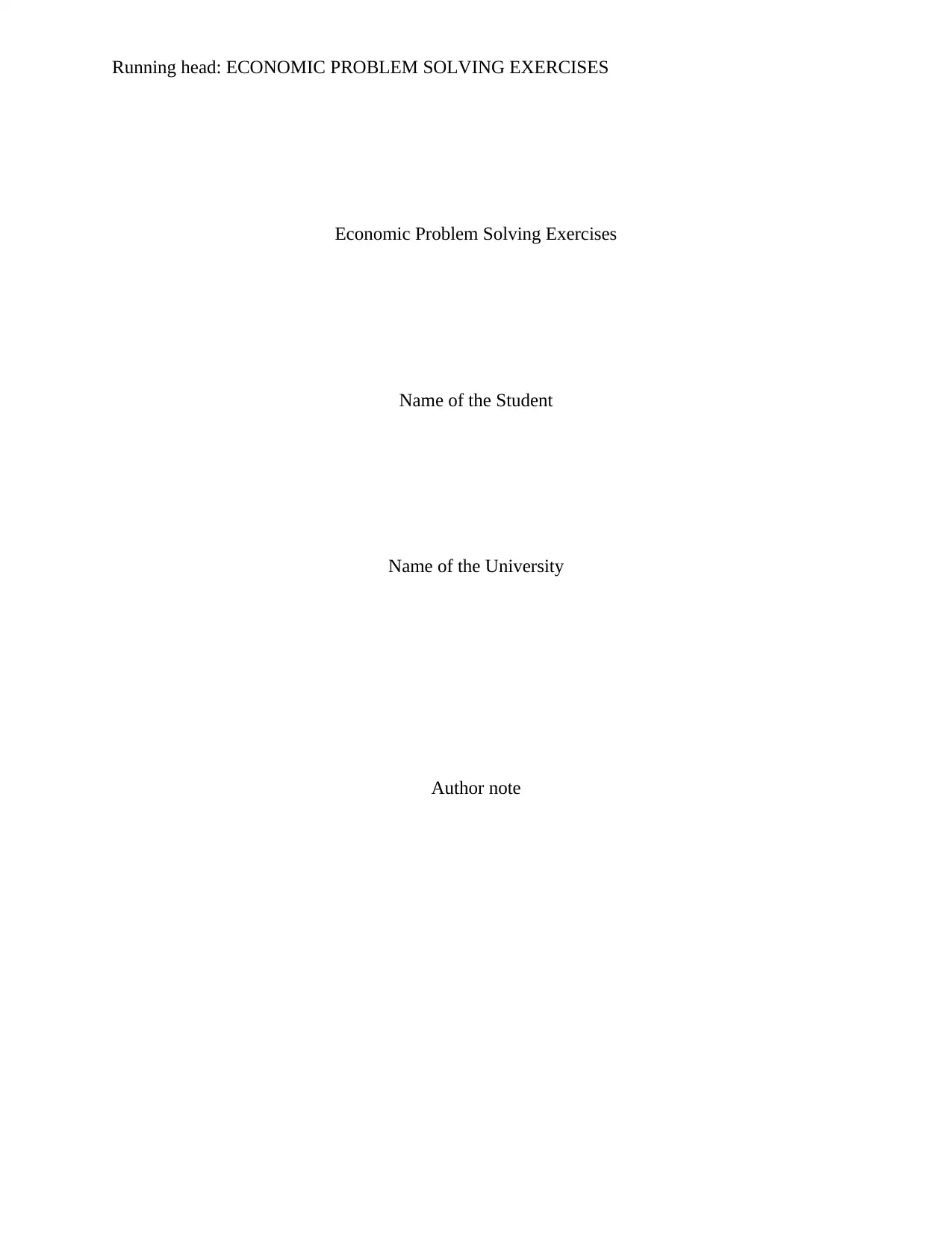
Running head: ECONOMIC PROBLEM SOLVING EXERCISES
Economic Problem Solving Exercises
Name of the Student
Name of the University
Author note
Economic Problem Solving Exercises
Name of the Student
Name of the University
Author note
Paraphrase This Document
Need a fresh take? Get an instant paraphrase of this document with our AI Paraphraser
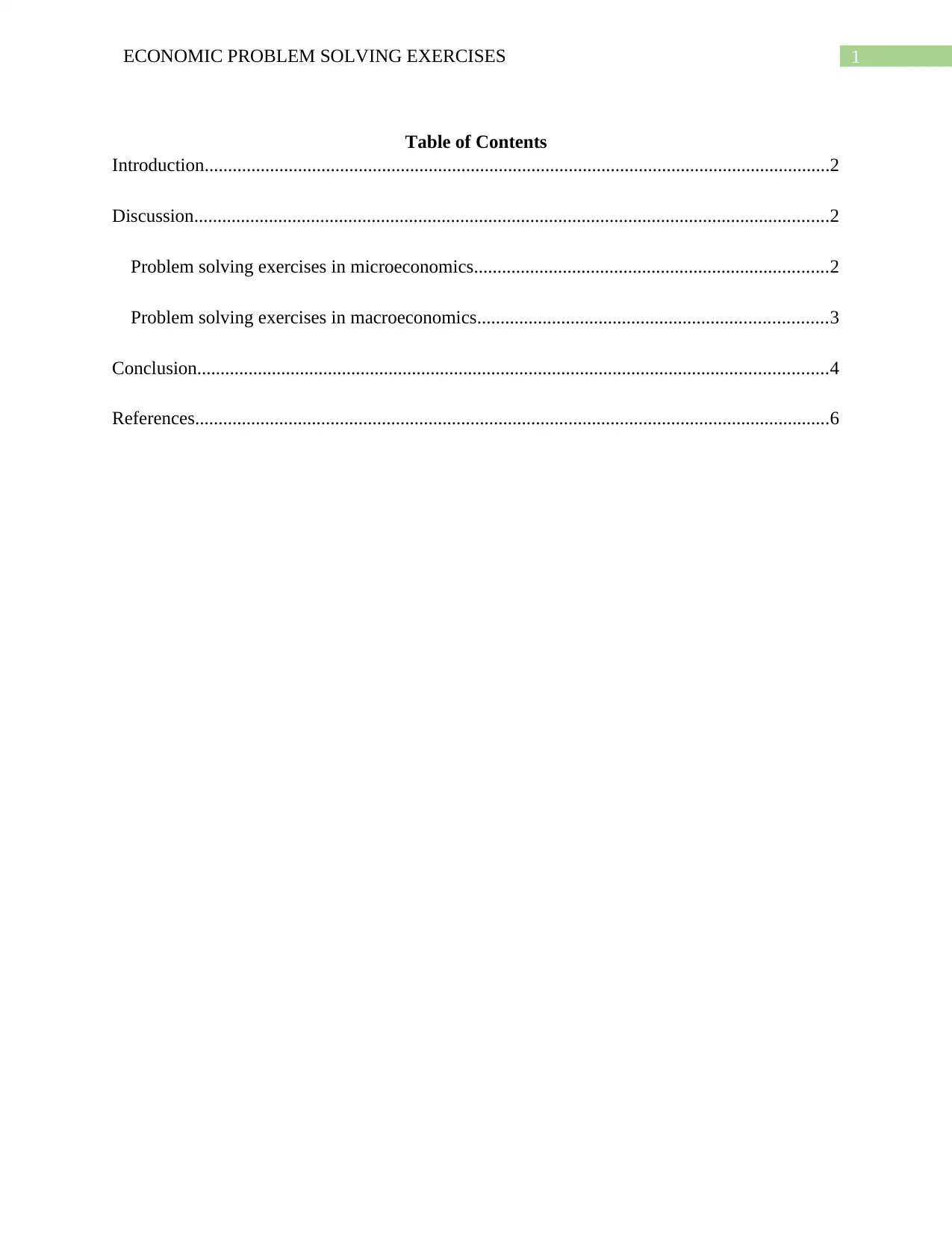
1ECONOMIC PROBLEM SOLVING EXERCISES
Table of Contents
Introduction......................................................................................................................................2
Discussion........................................................................................................................................2
Problem solving exercises in microeconomics............................................................................2
Problem solving exercises in macroeconomics...........................................................................3
Conclusion.......................................................................................................................................4
References........................................................................................................................................6
Table of Contents
Introduction......................................................................................................................................2
Discussion........................................................................................................................................2
Problem solving exercises in microeconomics............................................................................2
Problem solving exercises in macroeconomics...........................................................................3
Conclusion.......................................................................................................................................4
References........................................................................................................................................6
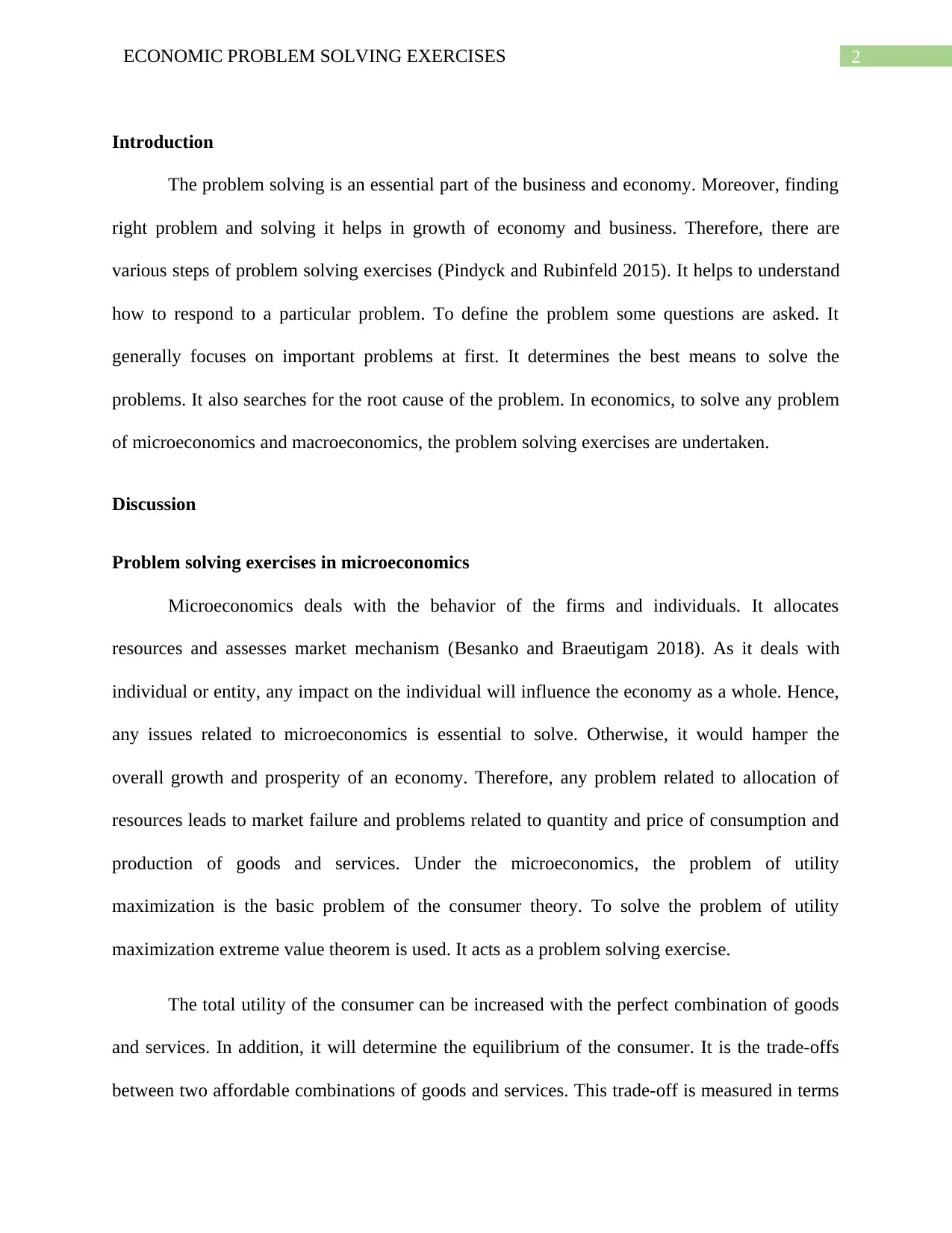
2ECONOMIC PROBLEM SOLVING EXERCISES
Introduction
The problem solving is an essential part of the business and economy. Moreover, finding
right problem and solving it helps in growth of economy and business. Therefore, there are
various steps of problem solving exercises (Pindyck and Rubinfeld 2015). It helps to understand
how to respond to a particular problem. To define the problem some questions are asked. It
generally focuses on important problems at first. It determines the best means to solve the
problems. It also searches for the root cause of the problem. In economics, to solve any problem
of microeconomics and macroeconomics, the problem solving exercises are undertaken.
Discussion
Problem solving exercises in microeconomics
Microeconomics deals with the behavior of the firms and individuals. It allocates
resources and assesses market mechanism (Besanko and Braeutigam 2018). As it deals with
individual or entity, any impact on the individual will influence the economy as a whole. Hence,
any issues related to microeconomics is essential to solve. Otherwise, it would hamper the
overall growth and prosperity of an economy. Therefore, any problem related to allocation of
resources leads to market failure and problems related to quantity and price of consumption and
production of goods and services. Under the microeconomics, the problem of utility
maximization is the basic problem of the consumer theory. To solve the problem of utility
maximization extreme value theorem is used. It acts as a problem solving exercise.
The total utility of the consumer can be increased with the perfect combination of goods
and services. In addition, it will determine the equilibrium of the consumer. It is the trade-offs
between two affordable combinations of goods and services. This trade-off is measured in terms
Introduction
The problem solving is an essential part of the business and economy. Moreover, finding
right problem and solving it helps in growth of economy and business. Therefore, there are
various steps of problem solving exercises (Pindyck and Rubinfeld 2015). It helps to understand
how to respond to a particular problem. To define the problem some questions are asked. It
generally focuses on important problems at first. It determines the best means to solve the
problems. It also searches for the root cause of the problem. In economics, to solve any problem
of microeconomics and macroeconomics, the problem solving exercises are undertaken.
Discussion
Problem solving exercises in microeconomics
Microeconomics deals with the behavior of the firms and individuals. It allocates
resources and assesses market mechanism (Besanko and Braeutigam 2018). As it deals with
individual or entity, any impact on the individual will influence the economy as a whole. Hence,
any issues related to microeconomics is essential to solve. Otherwise, it would hamper the
overall growth and prosperity of an economy. Therefore, any problem related to allocation of
resources leads to market failure and problems related to quantity and price of consumption and
production of goods and services. Under the microeconomics, the problem of utility
maximization is the basic problem of the consumer theory. To solve the problem of utility
maximization extreme value theorem is used. It acts as a problem solving exercise.
The total utility of the consumer can be increased with the perfect combination of goods
and services. In addition, it will determine the equilibrium of the consumer. It is the trade-offs
between two affordable combinations of goods and services. This trade-off is measured in terms
⊘ This is a preview!⊘
Do you want full access?
Subscribe today to unlock all pages.

Trusted by 1+ million students worldwide
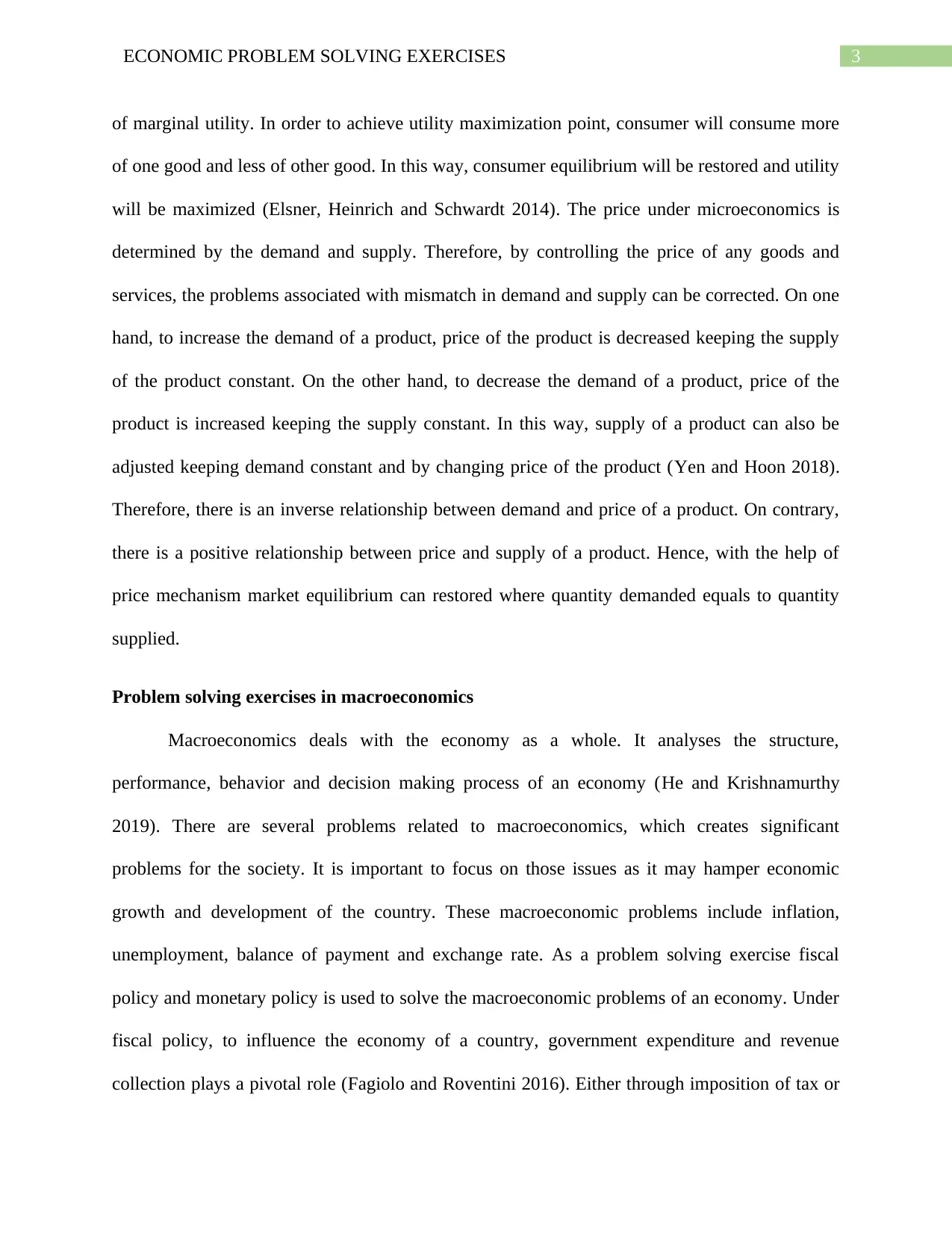
3ECONOMIC PROBLEM SOLVING EXERCISES
of marginal utility. In order to achieve utility maximization point, consumer will consume more
of one good and less of other good. In this way, consumer equilibrium will be restored and utility
will be maximized (Elsner, Heinrich and Schwardt 2014). The price under microeconomics is
determined by the demand and supply. Therefore, by controlling the price of any goods and
services, the problems associated with mismatch in demand and supply can be corrected. On one
hand, to increase the demand of a product, price of the product is decreased keeping the supply
of the product constant. On the other hand, to decrease the demand of a product, price of the
product is increased keeping the supply constant. In this way, supply of a product can also be
adjusted keeping demand constant and by changing price of the product (Yen and Hoon 2018).
Therefore, there is an inverse relationship between demand and price of a product. On contrary,
there is a positive relationship between price and supply of a product. Hence, with the help of
price mechanism market equilibrium can restored where quantity demanded equals to quantity
supplied.
Problem solving exercises in macroeconomics
Macroeconomics deals with the economy as a whole. It analyses the structure,
performance, behavior and decision making process of an economy (He and Krishnamurthy
2019). There are several problems related to macroeconomics, which creates significant
problems for the society. It is important to focus on those issues as it may hamper economic
growth and development of the country. These macroeconomic problems include inflation,
unemployment, balance of payment and exchange rate. As a problem solving exercise fiscal
policy and monetary policy is used to solve the macroeconomic problems of an economy. Under
fiscal policy, to influence the economy of a country, government expenditure and revenue
collection plays a pivotal role (Fagiolo and Roventini 2016). Either through imposition of tax or
of marginal utility. In order to achieve utility maximization point, consumer will consume more
of one good and less of other good. In this way, consumer equilibrium will be restored and utility
will be maximized (Elsner, Heinrich and Schwardt 2014). The price under microeconomics is
determined by the demand and supply. Therefore, by controlling the price of any goods and
services, the problems associated with mismatch in demand and supply can be corrected. On one
hand, to increase the demand of a product, price of the product is decreased keeping the supply
of the product constant. On the other hand, to decrease the demand of a product, price of the
product is increased keeping the supply constant. In this way, supply of a product can also be
adjusted keeping demand constant and by changing price of the product (Yen and Hoon 2018).
Therefore, there is an inverse relationship between demand and price of a product. On contrary,
there is a positive relationship between price and supply of a product. Hence, with the help of
price mechanism market equilibrium can restored where quantity demanded equals to quantity
supplied.
Problem solving exercises in macroeconomics
Macroeconomics deals with the economy as a whole. It analyses the structure,
performance, behavior and decision making process of an economy (He and Krishnamurthy
2019). There are several problems related to macroeconomics, which creates significant
problems for the society. It is important to focus on those issues as it may hamper economic
growth and development of the country. These macroeconomic problems include inflation,
unemployment, balance of payment and exchange rate. As a problem solving exercise fiscal
policy and monetary policy is used to solve the macroeconomic problems of an economy. Under
fiscal policy, to influence the economy of a country, government expenditure and revenue
collection plays a pivotal role (Fagiolo and Roventini 2016). Either through imposition of tax or
Paraphrase This Document
Need a fresh take? Get an instant paraphrase of this document with our AI Paraphraser
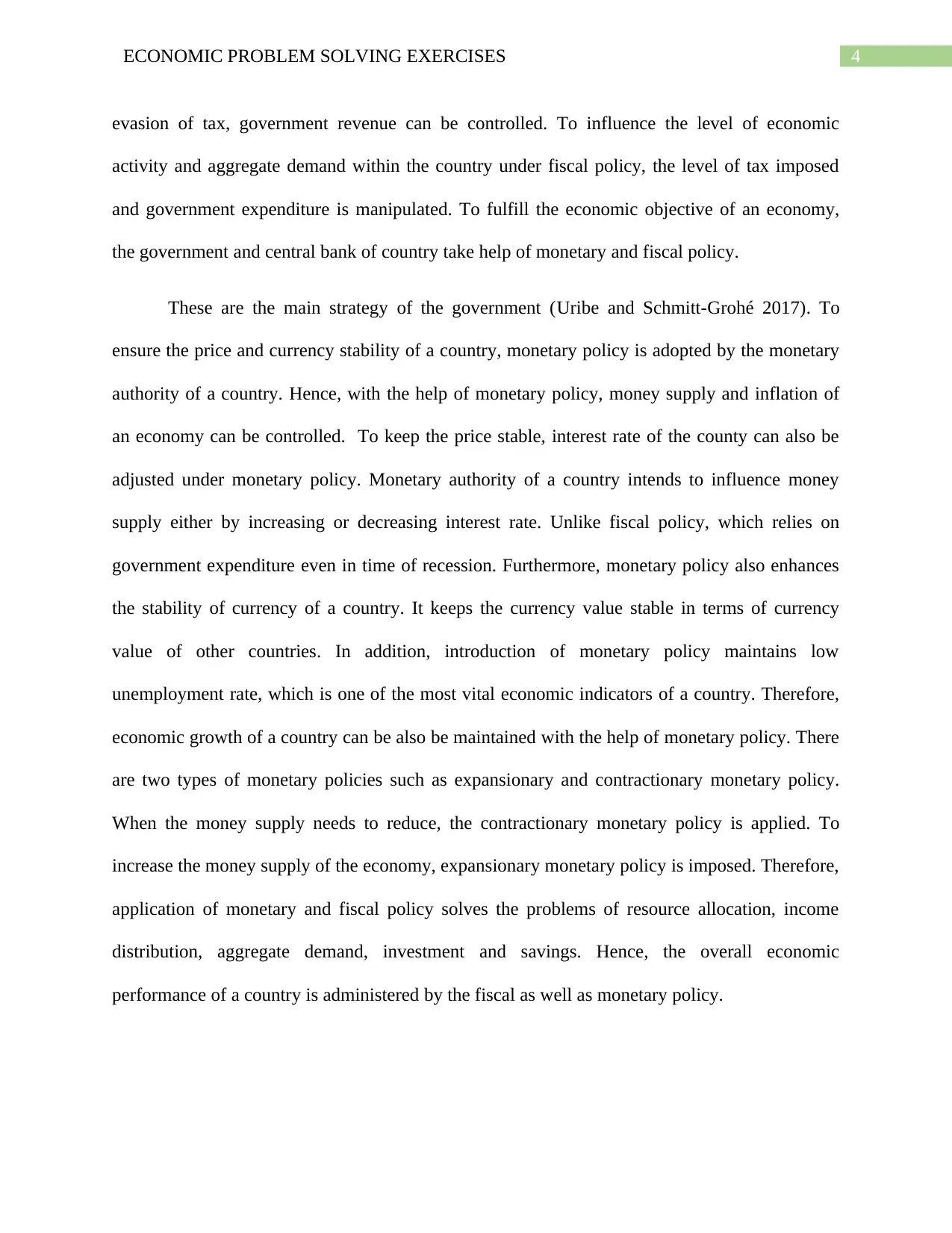
4ECONOMIC PROBLEM SOLVING EXERCISES
evasion of tax, government revenue can be controlled. To influence the level of economic
activity and aggregate demand within the country under fiscal policy, the level of tax imposed
and government expenditure is manipulated. To fulfill the economic objective of an economy,
the government and central bank of country take help of monetary and fiscal policy.
These are the main strategy of the government (Uribe and Schmitt-Grohé 2017). To
ensure the price and currency stability of a country, monetary policy is adopted by the monetary
authority of a country. Hence, with the help of monetary policy, money supply and inflation of
an economy can be controlled. To keep the price stable, interest rate of the county can also be
adjusted under monetary policy. Monetary authority of a country intends to influence money
supply either by increasing or decreasing interest rate. Unlike fiscal policy, which relies on
government expenditure even in time of recession. Furthermore, monetary policy also enhances
the stability of currency of a country. It keeps the currency value stable in terms of currency
value of other countries. In addition, introduction of monetary policy maintains low
unemployment rate, which is one of the most vital economic indicators of a country. Therefore,
economic growth of a country can be also be maintained with the help of monetary policy. There
are two types of monetary policies such as expansionary and contractionary monetary policy.
When the money supply needs to reduce, the contractionary monetary policy is applied. To
increase the money supply of the economy, expansionary monetary policy is imposed. Therefore,
application of monetary and fiscal policy solves the problems of resource allocation, income
distribution, aggregate demand, investment and savings. Hence, the overall economic
performance of a country is administered by the fiscal as well as monetary policy.
evasion of tax, government revenue can be controlled. To influence the level of economic
activity and aggregate demand within the country under fiscal policy, the level of tax imposed
and government expenditure is manipulated. To fulfill the economic objective of an economy,
the government and central bank of country take help of monetary and fiscal policy.
These are the main strategy of the government (Uribe and Schmitt-Grohé 2017). To
ensure the price and currency stability of a country, monetary policy is adopted by the monetary
authority of a country. Hence, with the help of monetary policy, money supply and inflation of
an economy can be controlled. To keep the price stable, interest rate of the county can also be
adjusted under monetary policy. Monetary authority of a country intends to influence money
supply either by increasing or decreasing interest rate. Unlike fiscal policy, which relies on
government expenditure even in time of recession. Furthermore, monetary policy also enhances
the stability of currency of a country. It keeps the currency value stable in terms of currency
value of other countries. In addition, introduction of monetary policy maintains low
unemployment rate, which is one of the most vital economic indicators of a country. Therefore,
economic growth of a country can be also be maintained with the help of monetary policy. There
are two types of monetary policies such as expansionary and contractionary monetary policy.
When the money supply needs to reduce, the contractionary monetary policy is applied. To
increase the money supply of the economy, expansionary monetary policy is imposed. Therefore,
application of monetary and fiscal policy solves the problems of resource allocation, income
distribution, aggregate demand, investment and savings. Hence, the overall economic
performance of a country is administered by the fiscal as well as monetary policy.
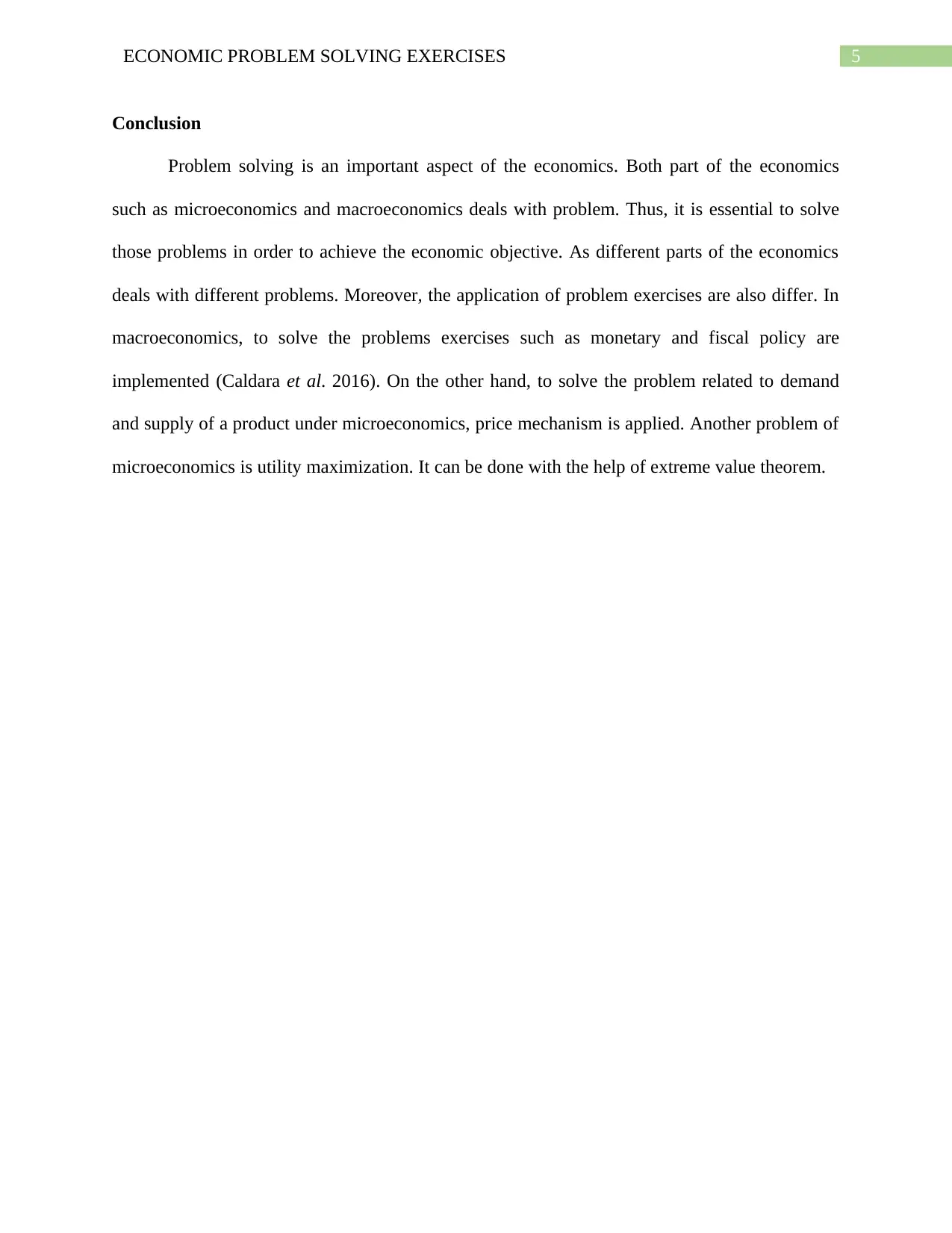
5ECONOMIC PROBLEM SOLVING EXERCISES
Conclusion
Problem solving is an important aspect of the economics. Both part of the economics
such as microeconomics and macroeconomics deals with problem. Thus, it is essential to solve
those problems in order to achieve the economic objective. As different parts of the economics
deals with different problems. Moreover, the application of problem exercises are also differ. In
macroeconomics, to solve the problems exercises such as monetary and fiscal policy are
implemented (Caldara et al. 2016). On the other hand, to solve the problem related to demand
and supply of a product under microeconomics, price mechanism is applied. Another problem of
microeconomics is utility maximization. It can be done with the help of extreme value theorem.
Conclusion
Problem solving is an important aspect of the economics. Both part of the economics
such as microeconomics and macroeconomics deals with problem. Thus, it is essential to solve
those problems in order to achieve the economic objective. As different parts of the economics
deals with different problems. Moreover, the application of problem exercises are also differ. In
macroeconomics, to solve the problems exercises such as monetary and fiscal policy are
implemented (Caldara et al. 2016). On the other hand, to solve the problem related to demand
and supply of a product under microeconomics, price mechanism is applied. Another problem of
microeconomics is utility maximization. It can be done with the help of extreme value theorem.
⊘ This is a preview!⊘
Do you want full access?
Subscribe today to unlock all pages.

Trusted by 1+ million students worldwide
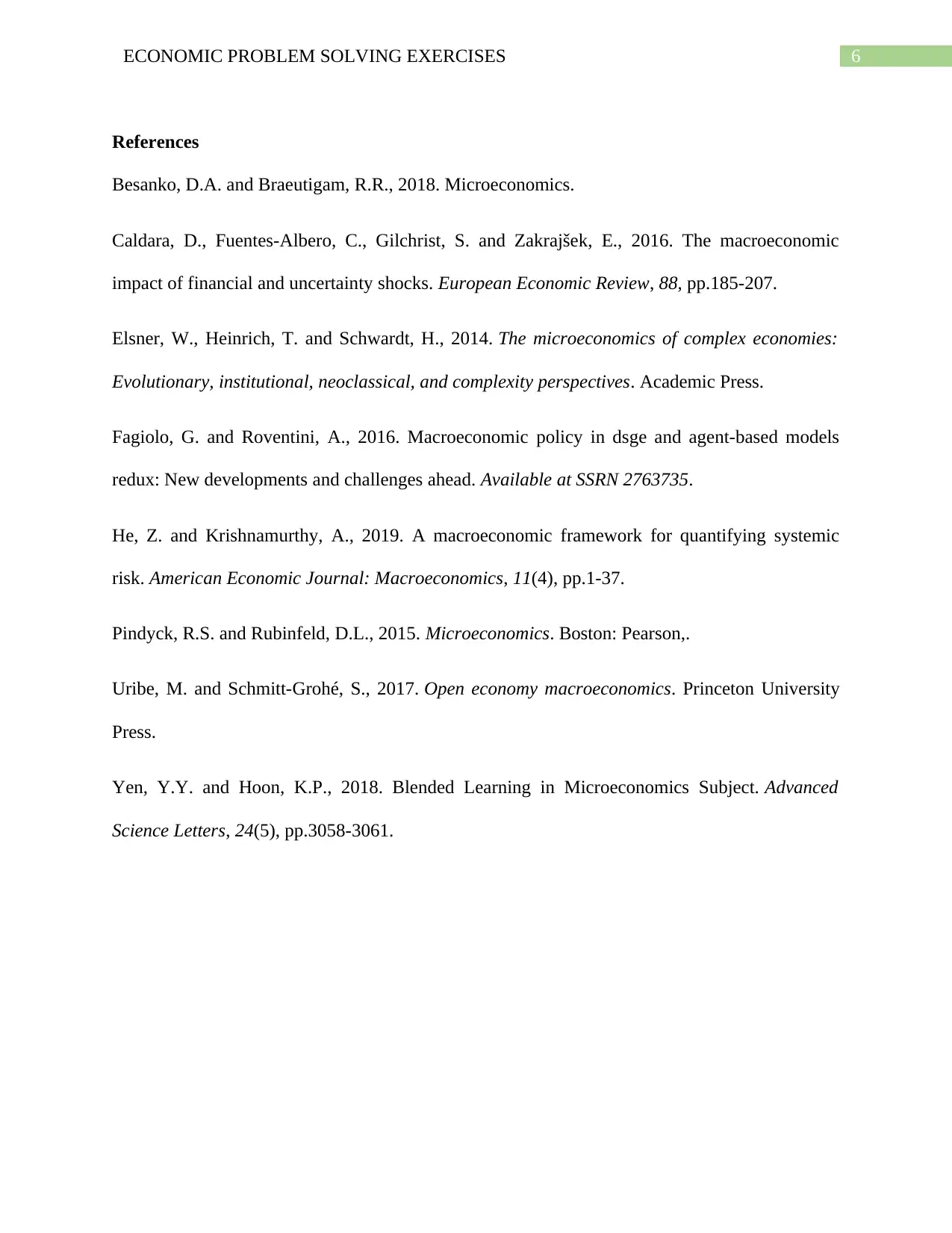
6ECONOMIC PROBLEM SOLVING EXERCISES
References
Besanko, D.A. and Braeutigam, R.R., 2018. Microeconomics.
Caldara, D., Fuentes-Albero, C., Gilchrist, S. and Zakrajšek, E., 2016. The macroeconomic
impact of financial and uncertainty shocks. European Economic Review, 88, pp.185-207.
Elsner, W., Heinrich, T. and Schwardt, H., 2014. The microeconomics of complex economies:
Evolutionary, institutional, neoclassical, and complexity perspectives. Academic Press.
Fagiolo, G. and Roventini, A., 2016. Macroeconomic policy in dsge and agent-based models
redux: New developments and challenges ahead. Available at SSRN 2763735.
He, Z. and Krishnamurthy, A., 2019. A macroeconomic framework for quantifying systemic
risk. American Economic Journal: Macroeconomics, 11(4), pp.1-37.
Pindyck, R.S. and Rubinfeld, D.L., 2015. Microeconomics. Boston: Pearson,.
Uribe, M. and Schmitt-Grohé, S., 2017. Open economy macroeconomics. Princeton University
Press.
Yen, Y.Y. and Hoon, K.P., 2018. Blended Learning in Microeconomics Subject. Advanced
Science Letters, 24(5), pp.3058-3061.
References
Besanko, D.A. and Braeutigam, R.R., 2018. Microeconomics.
Caldara, D., Fuentes-Albero, C., Gilchrist, S. and Zakrajšek, E., 2016. The macroeconomic
impact of financial and uncertainty shocks. European Economic Review, 88, pp.185-207.
Elsner, W., Heinrich, T. and Schwardt, H., 2014. The microeconomics of complex economies:
Evolutionary, institutional, neoclassical, and complexity perspectives. Academic Press.
Fagiolo, G. and Roventini, A., 2016. Macroeconomic policy in dsge and agent-based models
redux: New developments and challenges ahead. Available at SSRN 2763735.
He, Z. and Krishnamurthy, A., 2019. A macroeconomic framework for quantifying systemic
risk. American Economic Journal: Macroeconomics, 11(4), pp.1-37.
Pindyck, R.S. and Rubinfeld, D.L., 2015. Microeconomics. Boston: Pearson,.
Uribe, M. and Schmitt-Grohé, S., 2017. Open economy macroeconomics. Princeton University
Press.
Yen, Y.Y. and Hoon, K.P., 2018. Blended Learning in Microeconomics Subject. Advanced
Science Letters, 24(5), pp.3058-3061.
1 out of 7
Related Documents
Your All-in-One AI-Powered Toolkit for Academic Success.
+13062052269
info@desklib.com
Available 24*7 on WhatsApp / Email
![[object Object]](/_next/static/media/star-bottom.7253800d.svg)
Unlock your academic potential
Copyright © 2020–2025 A2Z Services. All Rights Reserved. Developed and managed by ZUCOL.




